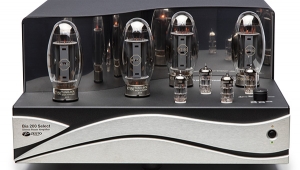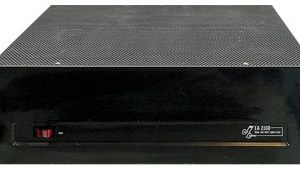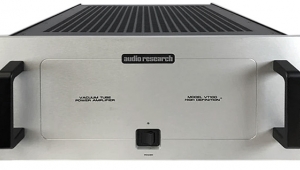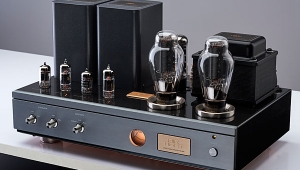| Columns Retired Columns & Blogs |
Rogue Audio M-180 monoblock power amplifier
Two audiophile buddies of mine both own Rogue Audio M-150 monoblocks. I'd always been impressed with not only the sound quality of the M-150, but also its price. For $4495/pair, I thought my friends got a whole lotta amp for notta lotta dough. In this day and age, it's a rare and wonderful thing to get a pair of monoblocks, made in the US by a real audio company, that give you 150Wpc of tube power for under $5000. When Rogue came out with an update of the M-150, the M-180 ($5495), I thought it might be a good subject for my first full review in Stereophile. John Atkinson thought so too. I also thought it would be interesting to compare the M-180 with the very tube-like and almost identically priced Pass Labs XA30.5 two-channel amplifier ($5500), a sample of which I had on hand. (see my Follow-Up in August 2009).

Each Rogue M-180 is based on four Electro Harmonix KT90 output tubes (vs the M-150's four KT88s). The M-180 can be run in the more powerful ultralinear mode, in which it achieves its claimed output of 180W; it puts out less juice when run in triode mode. You select the mode with the flick of a switch at the back of the amp. Tube biasing is easily adjusted by hand with four switches and a built-in meter, also on the rear panel. Each output tube can be biased individually, which will help in matching the tubes and lengthening their lives. Each M-180 has 4 and 8 ohm taps, and RCA and balanced inputs.
According to Rogue Audio's website, the $1000 difference between the M-150 and M-180 gets you "a fifty percent increase in power supply storage, a number of power supply modifications, PRP resistors in all critical spots, Cardas binding posts, Cardas input wiring and Cardas RCA jacks, different input circuitry, Hex Fred high-speed diodes for the bias supply, polypropylene bypass caps, KT90 output tubes and upgraded small signal tubes." Owners of M-150s can have Rogue upgrade their amps to M-180 status for $1295/pair.
The appearance of the M-180 is pleasingly simple. Its thick aluminum faceplate (I got mine in silver) has a circular cutout for the power switch and a glowing blue LED to tell you it's on. The build quality is quite good, though the thin metal plates covering the amp's other surfaces seemed a bit flimsy, ringing and even rattling when I pinged them with a fingernail. If I owned a pair, I'd be tempted to damp these panels with any number of substances made for that sort of thing. My only other, entirely personal, criticism of the M-180's appearance is that it doesn't show off its seven tubes, which are the back of the amp. It's generally accepted that owning tubes is cool. I want people who come to my house to see tubes in my stereo so they can, by the transitive property of coolness, think I'm cool.
Let me turn you on
Setting up the Rogue M-180s was a snap. I exclusively used their balanced inputs, fed directly from my Benchmark DAC1 D/A converter, and found that the 4 ohm taps worked best with my Revel F30 speakers, offering tighter bass and smoother treble response than the 8 ohm taps. This wasn't surprising, given the Revels' high-order crossovers, their nominal impedance of 6 ohms, and a few low dips in that impedance. Early on in my listening, I did a great deal of comparing the Rogues' triode and ultralinear modes. Given my love of single-ended solid-state amps, I was sure I'd prefer triode mode. Wrong. Though triode sounded a bit more relaxed, its lack of power was very obvious in my system. Triode mode also seemed to cast over the music what I heard as a slight veil or scrim, whereas ultralinear mode played to the M-180s' strengths of immediacy and in-the-room image palpability. After those early experiments, I pretty much left the Rogues in ultralinear mode.
The Rogues' sound opened up a great deal after they'd been played for about 100 hours, during which the tube biases also settled down: After that first 100 hours, the tubes held their biases very well, only occasionally needing a small adjustment—which I take as a sign of good design. I checked the bias often because I'm bit of a control freak and because it was fun to play with the Rogues' built-in bias meters. I also burned my thumb pretty badly on a KT90 tube one night after a couple of beers—a rookie mistake. Don't drink and bias, kids.
I'd like a bag of chips with a side of all that
My current system, which includes a Pass Labs Aleph 3 two-channel amplifier, has some real strengths and some real weaknesses. On the plus side, it has a natural and relaxed tonal balance with great harmonic coherence and a very articulate and detailed midrange. The Aleph 3 also has a tube-like sound and presents big, round stereo images, which can be very pleasant with many kinds of music. On the minus side, the Aleph regularly runs out of steam when played loudly. It also lacks that last bit of sparkle and air in the treble, and its bass is a bit round and floppy. I mention all this because, when I put a new amp in my system, I expect—or hope—that it will give me everything my current system does well, plus everything it doesn't. It was my hope the Rogue M-180s could give me natural harmonics, great detail, and lots of power, control, and drive.
- Log in or register to post comments



































